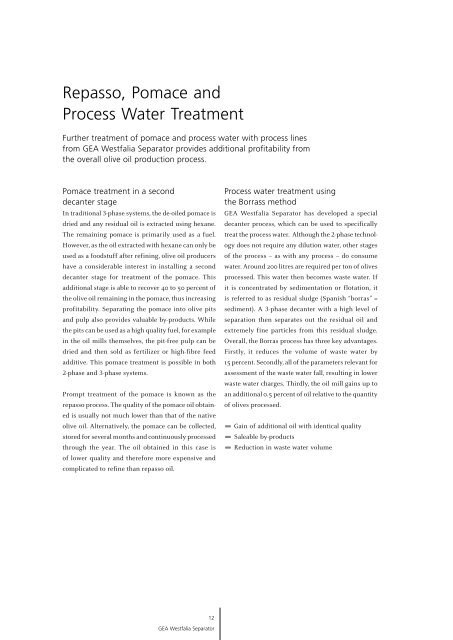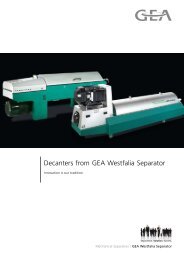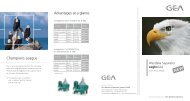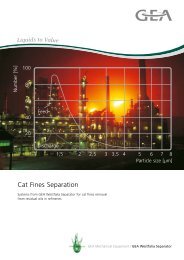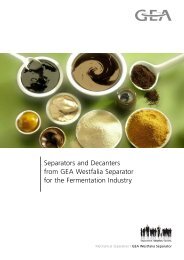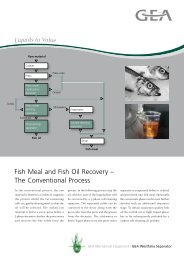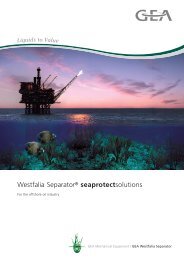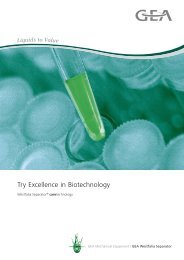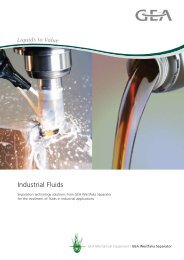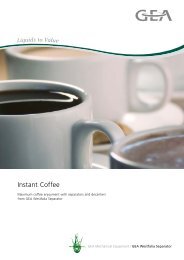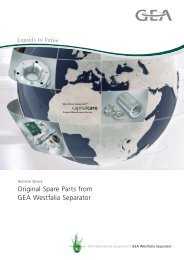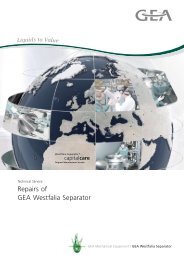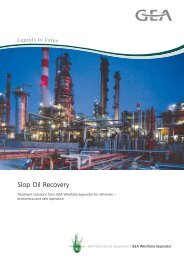Olive Oil Recovery pdf, 1.9 MB - GEA Westfalia Separator
Olive Oil Recovery pdf, 1.9 MB - GEA Westfalia Separator
Olive Oil Recovery pdf, 1.9 MB - GEA Westfalia Separator
You also want an ePaper? Increase the reach of your titles
YUMPU automatically turns print PDFs into web optimized ePapers that Google loves.
Repasso, Pomace andProcess Water TreatmentFurther treatment of pomace and process water with process linesfrom <strong>GEA</strong> <strong>Westfalia</strong> <strong>Separator</strong> provides additional profitability fromthe overall olive oil production process.Pomace treatment in a seconddecanter stageIn traditional 3-phase systems, the de-oiled pomace isdried and any residual oil is extracted using hexane.The remaining pomace is primarily used as a fuel.However, as the oil extracted with hexane can only beused as a foodstuff after refining, olive oil producershave a considerable interest in installing a seconddecanter stage for treatment of the pomace. Thisadditional stage is able to recover 40 to 50 percent ofthe olive oil remaining in the pomace, thus increasingprofitability. Separating the pomace into olive pitsand pulp also provides valuable by-products. Whilethe pits can be used as a high quality fuel, for examplein the oil mills themselves, the pit-free pulp can bedried and then sold as fertilizer or high-fibre feedadditive. This pomace treatment is possible in both2-phase and 3-phase systems.Prompt treatment of the pomace is known as therepasso process. The quality of the pomace oil obtainedis usually not much lower than that of the nativeolive oil. Alternatively, the pomace can be collected,stored for several months and continuously processedthrough the year. The oil obtained in this case isof lower quality and therefore more expensive andcomplicated to refine than repasso oil.Process water treatment usingthe Borrass method<strong>GEA</strong> <strong>Westfalia</strong> <strong>Separator</strong> has developed a specialdecanter process, which can be used to specificallytreat the process water. Although the 2-phase technologydoes not require any dilution water, other stagesof the process – as with any process – do consumewater. Around 200 litres are required per ton of olivesprocessed. This water then becomes waste water. Ifit is concentrated by sedimentation or flotation, itis referred to as residual sludge (Spanish “borras” =sediment). A 3-phase decanter with a high level ofseparation then separates out the residual oil andextremely fine particles from this residual sludge.Overall, the Borras process has three key advantages.Firstly, it reduces the volume of waste water by15 percent. Secondly, all of the parameters relevant forassessment of the waste water fall, resulting in lowerwaste water charges. Thirdly, the oil mill gains up toan additional 0.5 percent of oil relative to the quantityof olives processed.Gain of additional oil with identical qualitySaleable by-productsReduction in waste water volume12<strong>GEA</strong> <strong>Westfalia</strong> <strong>Separator</strong>


